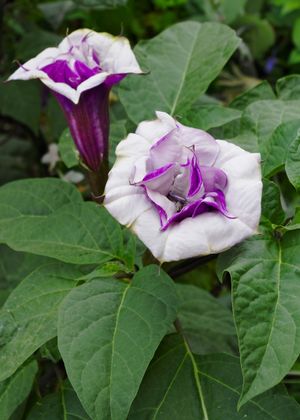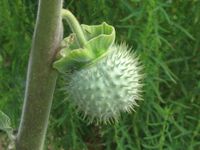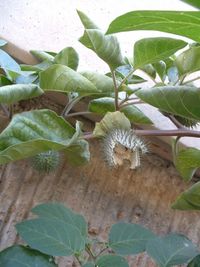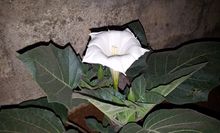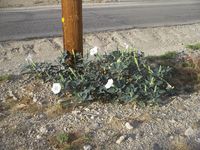داتورا
| داتورا | |
|---|---|

| |
| Datura metel | |
| التصنيف العلمي | |
| أصنوفة غير معروفة (أصلحها): | Datura |
| Type species | |
| Datura stramonium L.
| |
| Species | |
|
See text | |
Datura is a genus of nine species of poisonous vespertine flowering plants belonging to the family Solanaceae. They are commonly known as daturas, but also known as devil's trumpets,[1] not to be confused with angel's trumpets, its closely related genus Brugmansia. They are also sometimes called moonflowers, jimsonweed, devil's weed, hell's bells, thorn-apple, and many more. Its precise and natural distribution is uncertain, owing to its extensive cultivation and naturalization throughout the temperate and tropical regions of the globe. Its distribution within the Americas and North Africa, however, is most likely restricted to the United States and Mexico and Southern Canada in North America, and Tunisia in Africa, where the highest species diversity occurs.
All species of Datura are poisonous, especially their seeds and flowers.
Some South American plants formerly thought of as Datura are now treated as belonging to the distinct genus Brugmansia[2] (Brugmansia differs from Datura in that it is woody, making shrubs or small trees, and it has pendulous flowers, rather than erect ones). Other related taxa include Hyosyamus niger, Atropa belladonna, Mandragora officinarum, and many more.
Etymology
The name Datura is taken from Hindi धतूरा dhatūra 'thorn-apple',[3] ultimately from Sanskrit धत्तूर dhattūra 'white thorn-apple' (referring to Datura metel of Asia).[4] In the Ayurvedic text Sushruta different species of Datura are also referred to as kanaka and unmatta.[4] Dhatura is offered to Lord Shiva in Hindu/Santana religion. Record of this name in English dates back to 1662.[5] Nathaniel Hawthorne refers to one type in The Scarlet Letter as apple-Peru. In Mexico, its common name is toloache.
Description
Datura species are herbaceous, leafy annuals and short-lived perennials which can reach up to 2 m in height. The leaves are alternate, 10–20 cm long and 5–18 cm broad, with a lobed or toothed margin. The flowers are erect or spreading (not pendulous like those of Brugmansia), trumpet-shaped, 5–20 cm long and 4–12 cm broad at the mouth; colors vary from white to yellow, pink, and pale purple. The fruit is a spiny capsule 4–10 cm long and 2–6 cm broad, splitting open when ripe to release the numerous seeds. The seeds disperse freely over pastures, fields and even wasteland locations.
Datura belongs to the classic "witches' weeds", along with deadly nightshade, henbane, and mandrake. Most parts of the plants are toxic, and datura has a long history of use for causing delirious states and death. It was well known as an essential ingredient of potions and witches' brews.[6]
In India it has been referred to as "Poisonous" and as an aphrodisiac. In little measures it was used in Ayurveda as a medicine from the ancient times. It is used in rituals and prayers to Shiva. It is also used in Ganesh Chaturthi.
The larvae of some Lepidoptera (butterfly and moth) species, including Hypercompe indecisa, eat some Datura species.
Species and cultivars
Past classified species
Cultivation
Datura species are usually planted annually from the seed produced in the spiny pods, but with care, plants can be overwintered. Most species are suited to being planted outside or in containers. As a rule, they need warm, sunny places and soil that will keep their roots dry. When grown outdoors in good locations, the plants tend to reseed themselves and may become invasive. In containers, they should have porous, aerated potting soil with adequate drainage. The plants are susceptible to fungi in the root area, so anaerobic organic enrichment such as anaerobically composted organic matter or manure, should be avoided.[6]
Toxicity
All Datura plants contain tropane alkaloids such as scopolamine, hyoscyamine, and atropine, primarily in their seeds and flowers. Because of the presence of these substances, Datura has been used for centuries in some cultures as a poison.[6][7] There can be a 5:1 toxin variation between plants,[بحاجة لمصدر] and a given plant's toxicity depends on its age, where it is growing, and the local weather conditions. These variations make Datura exceptionally hazardous as a drug.
In traditional cultures, a great deal of experience with and detailed knowledge of Datura was critical to minimize harm.[6] Many tragic incidents result from modern users ingesting Datura. For example, in the 1990s and 2000s, the United States media contained stories of adolescents and young adults dying or becoming seriously ill from intentionally ingesting Datura.[8][9] There are also several reports in the medical literature of deaths from D. stramonium and D. ferox intoxication.[10][11][12] Children are especially vulnerable to atropine poisoning.[13][14]
Datura toxins may be ingested accidentally by consumption of honey produced by several wasp species, including Brachygastra lecheguana, during the Datura blooming season. It appears that these semi-domesticated honey wasps collect Datura nectar for honey production which can lead to poisoning.[15]
Treatment
Due to their agitated behavior and confused mental state, victims of Datura poisoning are typically hospitalized. Gastric lavage and the administration of activated charcoal can be used to reduce the stomach's absorption of the ingested material. The drug physostigmine is used to reverse the effect of the poisons. Benzodiazepines can be given to curb the patient's agitation, and supportive care with oxygen, hydration, and symptomatic treatment is often provided. Observation of the patient is indicated until the symptoms resolve, usually from 24–36 hours after ingestion of the Datura.[16][17]
Gallery
Legal status
See also
- Donnatal, a pharmaceutical containing the active alkaloids in Belladonna, a plant similar to Datura: scopolamine, hyoscyamine, and atropine, as a drug
المراجع
- ^ "Datura metel". plants.ces.ncsu.edu. Retrieved 17 يناير 2016.
- ^ Lester, R. N.; Nee, M.; Estrada, N. (1991). Hawkes, J. G. (ed.). Solanaceae III – Taxonomy, Chemistry, Evolution (Proceedings of Third International Conference on Solanaceae). Kew: Royal Botanic Gardens. pp. 197–210. ISBN 0-947643-31-1.
- ^ American Heritage Dictionary: datura
- ^ أ ب قالب:MWSD
- ^ the Oxford English Dictionary or OED
- ^ أ ب ت ث خطأ استشهاد: وسم
<ref>غير صحيح؛ لا نص تم توفيره للمراجع المسماةPreissel - ^ Adams, J. D. Jr.; Garcia, C. (2005). "Spirit, Mind and Body in Chumash Healing". Evidence-based Complementary and Alternative Medicine. 2 (4): 459–463. doi:10.1093/ecam/neh130. PMC 1297503. PMID 16322802.
- ^ Goetz, R.; Siegel, E.; Scaglione, J.; Belson, M.; Patel, M. (2003). "Suspected Moonflower Intoxication – Ohio, 2002". MMWR. Morbidity and Mortality Weekly Report. CDC. 52 (33): 788–791. PMID 12931077.
- ^ Leinwand, D. (1 نوفمبر 2006). "Jimson weed users chase high all the way to hospital". USA TODAY. Retrieved 15 فبراير 2009.
- ^ Michalodimitrakis, M.; Koutselinis, A. (1984). "Discussion of "Datura stramonium: A fatal poisoning"". Journal of Forensic Sciences. 29 (4): 961–962. PMID 6502123.
- ^ Boumba, V. A.; Mitselou, A.; Vougiouklakis, T. (2004). "Fatal poisoning from ingestion of Datura stramonium seeds". Veterinary and Human Toxicology. 46 (2): 81–82. PMID 15080209.
- ^ Steenkamp, P. A.; Harding, N. M.; Van Heerden, F. R.; Van Wyk, B.-E. (2004). "Fatal Datura poisoning: Identification of atropine and scopolamine by high performance liquid chromatography / photodiode array / mass spectrometry". Forensic Science International. 145 (1): 31–39. doi:10.1016/j.forsciint.2004.03.011. PMID 15374592.
- ^ Taha, S. A.; Mahdi, A. H. (1984). "Datura intoxication in Riyadh". Transactions of the Royal Society of Tropical Medicine and Hygiene. 78 (1): 134–135. doi:10.1016/0035-9203(84)90196-2. PMID 6710568.
- ^ Djibo, A.; Bouzou, S. B. (2000). "[Acute intoxication with "sobi-lobi" (Datura). Four cases in Niger]". Bulletin de la Société de Pathologie Exotique (in French). 93 (4): 294–297. PMID 11204734.
{{cite journal}}: CS1 maint: unrecognized language (link) - ^ Bequaert, J.Q. (1932). "The Nearctic social wasps of the subfamily polybiinae (Hymenoptera; Vespidae)". Entomologica Americana. 13 (3): 87–150.
- ^ خطأ استشهاد: وسم
<ref>غير صحيح؛ لا نص تم توفيره للمراجع المسماةSS1 - ^ Bliss, M. (2001). "Datura Plant Poisoning" (pdf). Clinical Toxicology Review. 23 (6).
للاستزادة
- Rätsch, C. (2005) [1998]. The Encyclopedia of Psychoactive Plants. Rochester, VT: Park Street Press. ISBN 978-0-89281-978-2.
- Bliss, M. (2001). "Datura Plant Poisoning" (pdf). Clinical Toxicology Review. 23 (6).
- article/816657 on eMedicine
- Roblot, F; Montaz, L; Delcoustal, M; Gaboriau, E; Chavagnat, JJ; Morichaud, G; Pourrat, O; Scepi, M; Patte, D (1995). "[Datura stramonium poisoning: the diagnosis is clinical, treatment is symptomatic]". La Revue de Médecine Interne (in French). 16 (3): 187–90. doi:10.1016/0248-8663(96)80689-8. PMID 7740228.
{{cite journal}}: CS1 maint: unrecognized language (link) - Krenzelok, Edward P. (فبراير 2010). "Aspects of poisoning and treatment". Clinical Toxicology. 48 (2): 104–110. doi:10.3109/15563651003630672. PMID 20229618.
وصلات خارجية
- "Datura Vault". Erowid.
